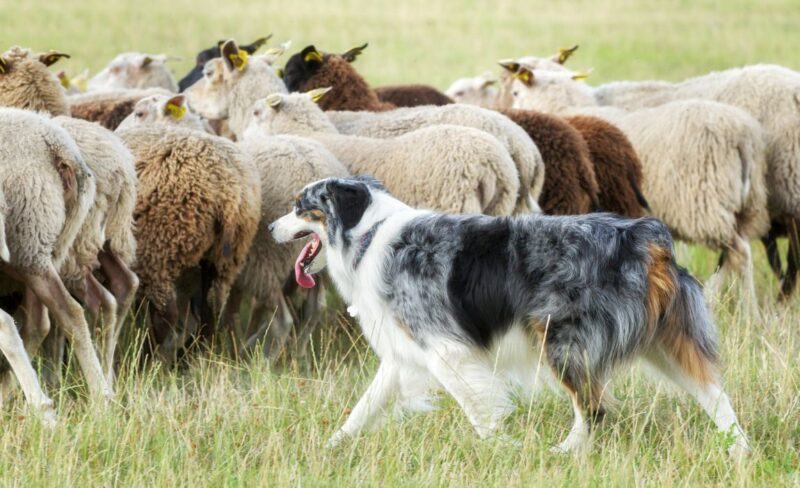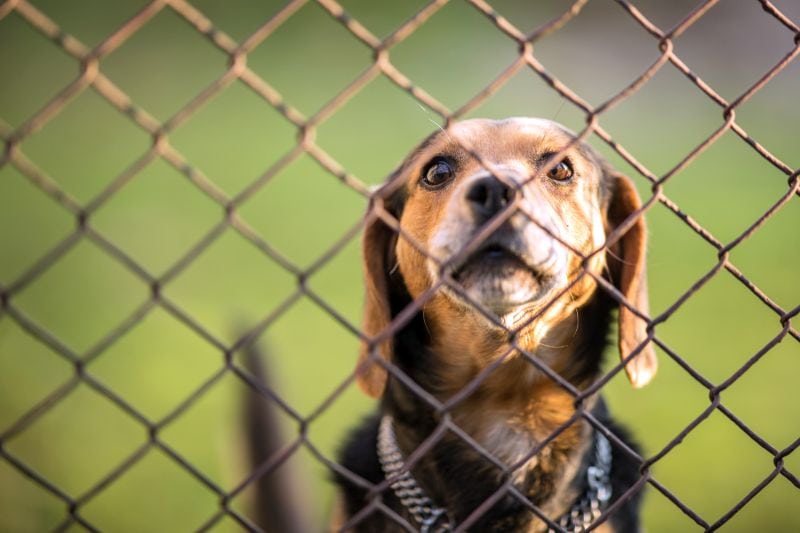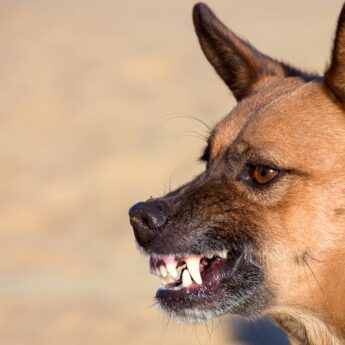Predatory aggression is a scary yet very common canine conundrum.
And because it’s often mislabeled or misinterpreted as other forms of aggression, it can cause frustration and headaches during the training process.
But don’t worry – there are management strategies and training exercises you can use to help address predatory problems!
Below, we’ll explain what predatory aggression is, how it differs from other forms of canine aggression, and what you can do in order to better manage dogs with high prey drives.
Key Takeaways: What Is Predatory Aggression and How Do You Manage It?
- Predatory aggression is an instinctual desire some dogs feel to pursue prey. It is more common in some hunting and tracking breeds – such as hounds and terriers – than others, but any dog can feel the compulsion to chase smaller animals.
- Training away your dog’s prey drive isn’t an option. Denying instinct-based behaviors like chasing game can lead to frustration, so aim to channel the need into safe activities like lure coursing or flirt pole play.
- Managing predatory aggression is key. Dogs with a high prey drive can get into heaps of trouble, from chasing and harming neighborhood cats to escaping your yard in pursuit of squirrels, making it important to keep your canine contained while still exercising his needs in less harmful ways.
What Is Predatory Aggression, Anyway??

Predatory aggression is an instinct-based behavior in which a dog stalks or chases smaller animals, intending to kill and possibly consume them.
In these scenarios, the dog exhibiting the predatory aggression is viewing the smaller animal as prey. These dogs are also commonly referred to as dogs with a high prey drive — they find stalking and chasing small animals nearly irresistible.
Predatory aggression isn’t your dog being a bully or intentionally ignoring you. Instead, your dog is actively hunting the animal to catch and kill it as part of something called the “predatory sequence.”
The Predatory Sequence
The predatory sequence is the natural sequence of events that occupy a predator who is seeking out prey.
The predatory sequence involves a series of steps, including:
- Orienting / Seeking
- Eye-Locking
- Stalking
- Chasing
- Grabbing
- Killing
- Dissecting
- Consuming

While all dogs have some kind of prey drive, certain dogs have a much more pronounced, higher prey drive than others. Dogs with an intense prey drive can spot a squirrel from dozens of yards away and will lock into them immediately. Other dogs may visually follow a squirrel who runs across their path, but won’t feel the intense need to chase it down.
Certain breeds have been bred to focus on specific phases of the predatory sequence, while leaving out others.
For example, shepherds and herding breeds have been bred to maintain the stalking and chasing aspects of the sequence, while intentionally breeding out the desire to kill (you wouldn’t want your sheep-herding dog to be constantly attacking your livestock).

Other breeds such ratter dogs and other vermin hunters have the entire predatory sequence extremely intact, as hunting and disposing of pests was their main job.
In suburbia, rabbits and squirrels are frequent targets of predatory aggression.
However, cats and small dogs can become victims too. In some cases, dogs may even exhibit predatory aggression in response to small children.
This makes the management of dogs exhibiting predatory aggression critical.
Is Predatory Aggression Really Aggression?

The answer here is a little murky: yes and no.
Whether predatory aggression really qualifies as aggression is a bit of a debate in dog training circles!
Aggression is hostile behavior, which certainly fits in cases where a dog chases and seriously harms or kills another animal.
At the same time, the mood or emotions of a dog exhibiting predatory aggression isn’t involved as it is with most other forms of aggression.
With predatory aggression, your dog reacts instinctively to movement versus acting out of feeling physical discomfort, annoyance, or fear.
Whether it falls entirely into the exact parameters of aggression or not, predatory behavior is still serious and needs special care to ensure everyone’s well-being.
Are Some Breeds More Likely to Have a High Prey Drive?

Predatory aggression occurs in many breeds, from tiny terriers to large, powerful working dogs. That said, an intense prey drive is more common in some breeds than others, including:
- Hounds: This group is chock full of breeds with high prey drives. Sighthounds like greyhounds, whippets, and basenjis are just a few of the laser-focused Fidos bred to pursue game at tremendous speeds, while scenthounds like bloodhounds and coonhounds sniff out and give chase to prey in packs during hunts before ultimately treeing (chasing the animal up a tree) or otherwise surrounding the target.
- Terriers and other tunneling breeds: Ratters like Cairns, fox terriers, and Norfolks are well-known for their strong prey drives, though people sometimes forget that the fun-loving dachshund started out as a fierce burrow-cruising canine, with his name translating to “badger dog” in German.
- Catch dogs: Dogo Argentinos, American pit bull terriers, and Presa Canarios are some of the muscular mutt athletes used to catch and hold prey during hunts. They are still used in the sport today, with feral hog hunting common in the southern U.S.
While some dogs love a good chase (we’re looking at you, collies, shepherds, and other herding breeds), they aren’t likely to kill and consume an animal once caught.
If they did, they wouldn’t be very good at the job they were bred for!
This is also true of some hunting dogs, including retrievers, who must retrieve downed game, not devour or mangle it.
How Do You Fix Predatory Aggression?

Predatory aggression isn’t something you “fix” as much as it’s something you manage.
Why?
Because predatory aggression occurs when your dog acts on instinct. Denying your dog’s natural instincts isn’t a realistic solution to this issue, as it can lead to frustration. And a frustrated dog whose needs aren’t being met often becomes more likely to exhibit other unwanted behaviors or even spill over into other forms of aggression.
Instead, you’ll want to control your dog’s prey drive by managing their environment through management strategies and offer alternative activities that can redirect some of those natural prey-chasing behaviors.
Provide Plenty of Enrichment Opportunities
A key aspect of canine enrichment is offering a safe outlet for your dog to channel his natural instincts.
For dogs with a high prey drive, this doesn’t mean releasing live animals in your fenced-in yard and letting your pooch practice his assassin skills on living creatures — instead, we’d suggest alternative activities like:
Flirt Pole. A flirt pole is basically a giant cat toy, with a lure toy tied to the end of a long rope, with the other end of the rope attached to a stick that you use to control the lure. You’ll move the lure toy around, encouraging your dog to chase and grab the toy before letting it go and restarting the game.
Dogs with high prey drive absolutely love this game, and it’s one of the easiest ways to let your dog burn off some of that prey-drive instinct.
Soft Toy Dissection. We’re happy to scream it from the roof tops — let your dog destroy his toys! Ripping apart soft toys is a very natural dog behavior (specifically, it’s the section of the predatory sequence referred to as “dissection”). We’ve all groaned in annoyance when our dogs destroy a $20 toy within minutes, but it’s actually really healthy to let them tear up those toys.
Pro tip? Grab soft toys for cheap at Goodwill and let your dog tear ’em apart. Just make sure to only choose stuffed animals with all soft material features — avoid toys with beaded eyes, buttons, or other hard features your dog could easily tear off and swallow.
Cardboard Shredding. Cardboard shredding is another opportunity for your dog to practice dissection. Stuff some crumpled newspaper into an empty toilet paper or paper towel roll and let your dog have at it! If your dog needs extra encouragement, roll some treats or kibble up in the newspaper before stuffing it into the toilet paper roll. Small cardboard boxes your dog can fit his jaws around also work great!
Lure Coursing. Lure coursing is a popular dog sport in which a dog chases a soft toy that’s attached to a circuit set up around a yard or field. It’s basically like a flirt pole on steroids! For an at-home lure course, check out SwiftPaws.
Barn Hunts. A “barn hunt” is an AKC-recognized sport that allows the doggos to “hunt” rodents without putting the little buck-toothed critters in harm’s way. This is an especially popular sport for ratting breeds like Jack Russell Terriers!
Interactive Dog Toys. Some interactive dog toys are intentionally designed to simulate certain aspects of the predatory sequence, such as toys that move around the house or require pulling apart. The Outward Hound Hide-A-Squirrel is one of the best dog toys for dogs with a high prey drive, as it very much mimics the experience of snuffing out a squirrel!
Snuff Mats. Snuffle mats are fun canine puzzles that require a dog to search through folds of fabric in order to find tasty treats hidden within the soft material.
It’s common for owners to question the logic of allowing a dog to practice behaviors they want to avoid — won’t giving my dog something to chase or tear apart encourage him?
Preventing a dog from practicing unwanted behaviors definitely makes sense for certain issues like reactivity and stranger aggression.
But, for natural, instinct-driven behaviors, it’s actually better to give dogs an alternative outlet.
So, if your dog is chewing on the furniture, giving your dog an appropriate chew toy and encouraging him to redirect his chewing to that will actually lessen his destructive furniture-chewing — not exacerbate it!
The same holds true for aspects of the predatory sequence too.
When dogs are allowed to exercise their instincts and natural behaviors in a safe, appropriate setting, it results in a calmer, happier, more well-adjusted canine!
Nosework. Nosework is another canine sport that can be a great outlet for dogs with predatory aggression. Dogs must use their sniffer in order to find treats or specific scents hidden inside or outdoors.
Safely Contain Your Dog
For the safety of other animals and small children, you’ll want to keep any dog prone to predatory aggression contained and prevent him from escaping your property.
A six-foot dog-proof fence he can’t see through is best, as it will usually eliminate the risk of him trying to hop over or dig under the barrier in pursuit of passing critters he catches a glimpse of.

We generally try to steer owners away from invisible “electric” fences, due to the aversive nature of these tools, but they are an especially bad idea with dogs exhibiting predatory aggression, as they rarely work well for dogs on the chase. A dog with a high prey drive will easily (and without a thought of the consequences) rip right through an electric fence if their drive is high enough and they see a small animal run past them!
Caution needs to also be extended to safely walking a dog with a high prey drive, as sadly, we often hear about the disastrous results of a high-drive dog escaping a leash in pursuit of a small four-footer.
A dog with predatory aggression should always be kept on an escape-proof dog harness that he can’t wiggle out of easily, along with a sturdy leash you can grip securely.
Practice Disengaging from Triggers
The truth is that you’ll likely never completely eliminate your dog’s predatory aggression, as it’s an instinct that goes very deep and isn’t really something your dog has much control over.
However, you can practice specific cues and training that will go a long way toward better controlling your dog’s prey drive.
Specifically, you’ll want to practice getting your dog to disengage from triggers. So, teaching your dog to break his focus from squirrels who run up a tree, rabbits who scurry across the yard, etc.
The engage/disengage game is great for this!
Have some really drool-worthy, high-end treats ready and offer one whenever your dog is able to break his focus from a prey animal and look at you instead. We have a video below demo-ing how it’s done:
This is a common exercise to use with reactive dogs who struggle with staying calm around strange dogs or people, but it works for easing predatory aggression too.
Keep in mind this won’t be easy for your dog, and you might have to start out practicing several yards away from prey, at a position where your dog can stay under threshold (aka calm enough to not lose his head).
The good news is that this is where your training can shine, as good leash manners, a high-quality lead, and desensitization and counterconditioning training go a long way in keeping everyone safe.
Obviously, this means off-leash walking with a high-prey drive dog is out of the question. It’s just not worth the risk. Not only can your dog seriously injure a kiddo or another animal, but he may run off and get lost.
Some owners will actually allow their dog to chase down a squirrel as a reward for good listening.
When a dog can successfully listen to your cue to re-focus on you and disengage from a prey trigger, it may be appropriate to reward your dog by allowing him to go chase the prey (in certain, controlled contexts).
It will take your dog a long time to get to this point, and some owners choose to never allow chasing prey to be used as a reward.
But, being given permission to chase down a squirrel can definitely be a huge motivator for dogs (just as powerful or even more powerful than food), so it’s an option to consider.
Avoid Your Dog’s Prey Triggers
While you can’t really prevent squirrels from wandering into your yard, you can avoid other situations that may trigger your dog’s instincts. So for example, if you have a neighbor who owns chickens, you’ll want to consider avoiding their street on your daily walks.

Dogs with a high prey drive aren’t the best option for doggy daycare or dog parks, either. Your greyhound might be fine with a pack of flat-coated retriever friends, but introducing a small dog to the dynamic may not have the same peachy results.
And while we know most dog parks have large and small dog sections, unfortunately, not every owner follows the rules. It’s better to err on the side of caution for your dog’s sake because even if the other owner placed their dog in the wrong area, ultimately, your dog will be seen as the problem.
Don’t worry though — there are plenty of dog park alternatives you can take advantage of!
It’s also a good idea to skip walking near playgrounds, skate parks, or biking trails where your dog may want to chase small kiddos or passing bikes. Odd-looking moving targets can just be really tough for some dogs — and that’s OK, but we need to protect these pups from themselves!
Most notably, dogs with a high prey drive shouldn’t be left alone with small children or pets — ever. If you have a multi-pet household where a high-prey drive dog is usually OK with other pets, but not always, consider using dog gates to limit pet-on-pet interactions, and always crate your prey-driven dog when you won’t be home.
How Is Predatory Aggression Different from Other Types of Aggression?

While other dog aggression issues are often rooted in emotions like fear or over-arousal, predatory aggression is driven by your dog’s genetics.
Certain breeds of domestic dogs have been bred for hunting and killing pests for thousands of years, making strong prey drives deeply ingrained in specific breeds.
This is why predatory aggression differs from other forms of canine aggression –- and the ways you handle and treat it differs as well.
There are many other types of aggression in dogs aside from predatory aggression, including:
- Territorial Aggression: Dogs struggling with territorial aggression dogs bark, lunge, or race along the boundaries of homes and property in response to seeing a strange dog or person approaching. Any breed can display territorial aggression, though it’s most common in guardian breeds like shepherds, Rottweilers, and mastiffs.
- Possession Aggression: Also known as resource guarding, possession aggression occurs when a dog guards items like food, bones, and toys from people or other canines. This is a common source of conflict between multiple dogs living in a house together.
- Maternal Aggression: When protecting their pups, mama dogs can be more like mama bears. In fact, a new pup parent may growl or snap at you or other dogs in the family for a few weeks. In these cases, you need to manage mama’s aggression by giving her space to rear her puppies without people or other four-footed housemates interrupting. In time, mama’s protectiveness will fade, allowing you to safely handle and socialize the puppies.
- Social-Conflict Aggression: This form of aggression occurs between dogs and is based on interaction, usually when one pup isn’t respecting another one’s boundaries. Dogs living in the same household may have these sorts of beefs, but it’s also common at dog parks, particularly with undersocialized dogs.
- Sexual Aggression: Intact dogs may act aggressively in response to a mate, whether it’s males competing over a female or females seeking access to a male. In other cases, a female may snap at a male trying to mount her.
We have a full guide on the different types of dog aggression, if you’re looking to learn more.
Correctly identifying your dog’s type of aggression is essential in managing the behavior. If you’re unsure if your dog is displaying predatory aggression or another form or are unsure of how to proceed in training, contact a certified canine behaviorist for assistance.
Predatory Aggression: FAQ

Understanding the complexities of canine behaviors like predatory aggression is difficult, so don’t feel bad if you still have some questions!
Check out the most commonly asked predatory aggression questions below for some need-to-know information.
What causes predatory aggression in dogs?
Predatory aggression is linked to your dog’s instinctive prey drive. Many dog breeds were originally bred to kill pests or aid in hunting, and these instincts remain strong today, even as many have gone on to become certified couch cuddlers.
Predatory aggression is triggered by something running, most commonly a small animal like a rabbit, squirrel, or cat. Running children or passing bicyclists can also trigger a chase response in a dog with a high prey drive.
Can you eliminate predatory aggression via training?
Not completely. Predatory aggression is based on instinct, and denying instinct will only lead to frustration in your dog, potentially causing other forms of aggression.
Instead, you should manage your dog’s high prey drive by providing safe outlets through toys and activities while keeping him secure. That means investing in good fencing and keeping him leashed at all times when he’s outside of fenced areas.
In some cases, you can lessen your dog’s predatory aggression through training that focuses on desensitization and counterconditioning games.
How do you know if your dog is predatory?
Aside from knowing your breed’s background, you can determine if your dog has predatory aggression versus another kind of aggression by analyzing his behavior.
A dog with predatory aggression will pursue smaller animals in the yard or try to chase after them while on a leash. Your pup may occasionally catch and kill small animals, too, like squirrels, rabbits, and voles.
All that said, it is always best to consult with a certified dog behavior consultant if you believe your dog may be exhibiting predatory tendencies.
Can a dog with a high prey drive live with small dogs or cats?
Maybe. Dogs with high prey drives often live uneventful lives with small pets, but that doesn’t mean you shouldn’t be careful.
Don’t leave a dog with a high prey drive alone with cats, for instance, or trust them around your flock of backyard chickens. Careful introduction and training can keep everyone safe, but caution is warranted.
***
Predatory aggression can complicate day-to-day life with your doggo, but with proper management, your dog can exercise his instincts without causing any actual harm, leaving you both happier at the end of the day.
Do you have any tips for owners of dogs with high prey drives? Is there an activity your high-drive dog enjoys? Share with us in the comments. We’d love to hear about it.








No Comments